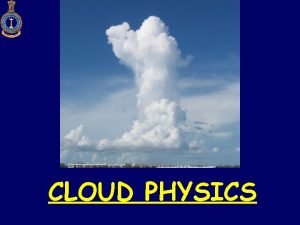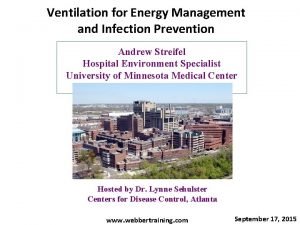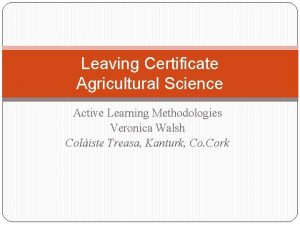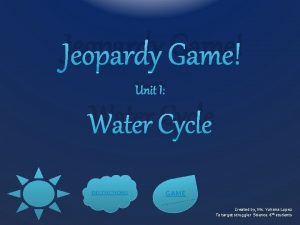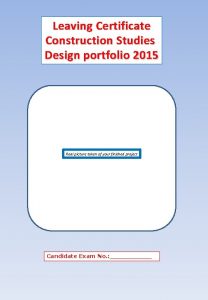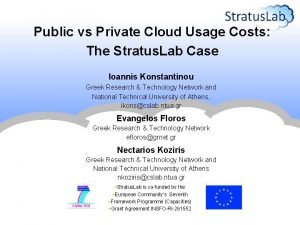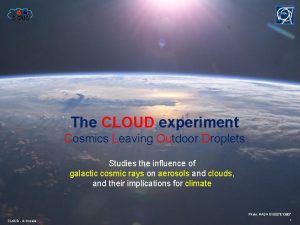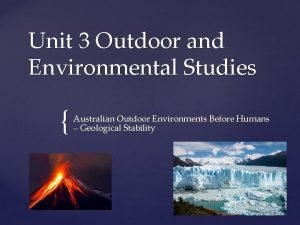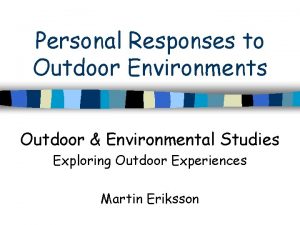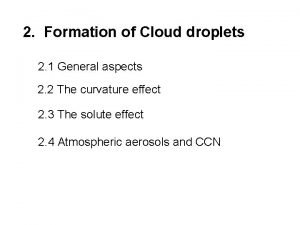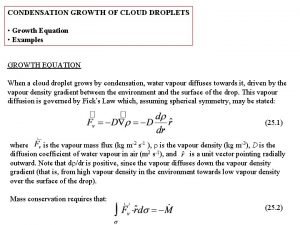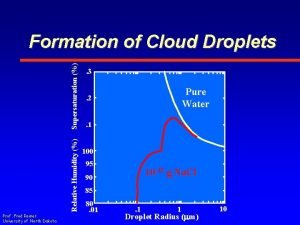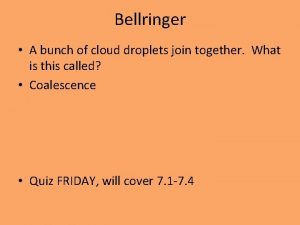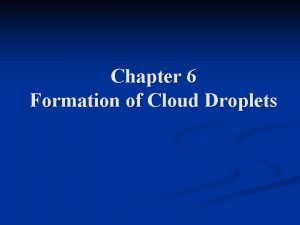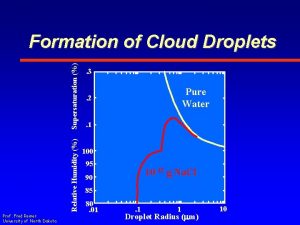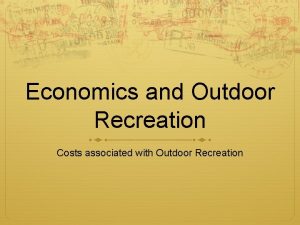The CLOUD experiment Cosmics Leaving Outdoor Droplets Studies


































- Slides: 34

The CLOUD experiment Cosmics Leaving Outdoor Droplets Studies the influence of galactic cosmic rays on aerosols and clouds, and their implications for climate Photo: NASA ISS 007 E 10807 CLOUD - A. Onnela 1

Agenda • Background: Earth’s climate, cosmic rays, aerosols and clouds • CLOUD Experiment: Concept, methods, results • Visit to CLOUD - A. Onnela 2

Earth’s climate Source: U. S. National Science Foundation, 2008 CLOUD - A. Onnela 3

Global surface temperature ΔT = 0. 8 o. C Year Source: IPCC, Summary for Policymakers, 2013 CLOUD - A. Onnela 4

Climate radiative forcings in Industrial Age A. Anthropogenic aerosol forcings are poorly understood. B. Natural part is very small. Is there a missing natural forcing? Is that from varying cosmic ray flux, modulated by sun? Source: IPCC, Summary for Policymakers, 2013 CLOUD - A. Onnela A + B The CLOUD experiment 5

Link between Cosmic rays and Climate ? • • Numerous correlations suggest GCR-climate connection. But no established mechanism to explain this. Several recent observations, e. g. by Eichler et al. , ACP, 2009: Correlation between GCRs and temperature in Siberia from glacial ice core data. CLOUD - A. Onnela 6

Cosmic rays High energy particles from outer space • Mostly protons; ~90% • Helium nuclei (alpha particles); ~9% • Others: Electrons, heavy nuclei; 1% Earth atmosphere protects from the cosmic rays • Lacking protection against cosmic rays is a major problem for long space travels. CLOUD - A. Onnela 7

Solar Cosmic ray Climate mechanism? ? • Higher solar activity → reduced GCRs → reduced cloud cover → warmer climate • Satellite observations not yet settled: Significant GCR-cloud correlations reported by some (Svensmark, Laken. . . ) and weak or excluded by others (Kristjansson, Wolfendale. . . ) CLOUD - A. Onnela 8

Role of aerosols on sun’s radiative forcing • • All cloud droplets form on aerosol “seeds” known as cloud condensation nuclei - CCN Cloud properties are sensitive to number of droplets More aerosols/CCN: – Brighter clouds, with longer lifetimes Sources of atmospheric aerosols: – Primary (dust, sea salt, fires) – Secondary (gas-to-particle conversion) See youtube: “No particles no fog” https: //www. youtube. com/watch? v=Ene. Dwu 0 Hr. Vg CLOUD - A. Onnela 9

What is an aerosol? Definition: Suspension of small (liquid or solid) particles in a gas Diesel soot: ca. 0. 1 μm Sea salt: 0. 2 - 10 μm Ammonium sulfate: ca. 0. 1 μm Mineral dust: 0. 2 - 10 μm Pollen: 10 - 100 μm

Primary Aerosol Sources Sea spray Mineral dust Volcano ► Sulfates, dust Biomass burning ► Organics Traffic emissions ► Soot CLOUD - A. Onnela Industrial Emissions 11

Secondary aerosol production: Gas-to-particle conversion Solar wind modulates • Trace condensable vapour → CN → CCN • But contributing vapours and nucleation rates poorly known • H 2 SO 4 is thought to be the primary condensable vapour in atmosphere (sub ppt) • Ion-induced nucleation pathway is energetically favoured but limited by the ion production rate and ion lifetime • Candidate mechanism for solar-climate variability This secondary aerosol formation is the key object of study in CLOUD - A. Onnela 12

Primary vs. secondary aerosols Origin of global cloud condensation nuclei, CCN, 500 -1000 m above ground level Merikanto et al. , ACP, 2009 About 50% of all cloud drops are formed on secondary aerosols Secondary aerosol formation – nucleation is poorly understood and is the key object of study in CLOUD - A. Onnela 13

CLOUD experiment concept 7. Carefully flush the chamber and clean the chamber walls between experiments 1. Fill chamber with clean air + water vapour 2. Set temperature and pressure Chamber 3. Add trace gases, condensable species in atmospheric, extremely low concentrations Controlled experimental ‘sample’ of Earth’s atmosphere ~1 molecule in 1012 air molecules 4. Expose to ionizing beam, and possibly to UV-light CLOUD - A. Onnela 6. Repeat experiment (typically some hours), possibly with varying parameters 5. Observe • Particle growth size distribution • Electrical charge distribution • Cloud droplet/ice particle concentrations, • etc. 14

CLOUD Unique capabilities: • temperature stability: <0. 1°C • temperature range: -90°C to +30°C; cleaning at +100°C • surface cleanliness: <10 pptv*) organics contamination, stainless steel (and gold), no teflon, no O-rings • ultrapure gas supplies • UV system: negligible heat load by use of fibre optics. • field cage 30 k. V/m Highly advanced aerosol chamber already as such! *) pptv = part per trillion, 1 / 1012 CLOUD - A. Onnela 15

CLOUD - A. Onnela 16

CLOUD in CERN PS-T 11 beam PS East Hall T 11 beam area (3. 5 Ge. V/c) Proton Synchrotron (PS) accelerator, first operation in 1959 CLOUD - A. Onnela 17

CLOUD in CERN PS-T 11 beam Here! CLOUD - A. Onnela 18

CLOUD Aerosol chamber • 27 m 3 • Pressure: Atmospheric ± 0. 3 bar • Only metallic seals • Electropolished inner surfaces CLOUD - A. Onnela 19

Aerosol chamber in T 11 September 2009 July 2009 CLOUD - A. Onnela 20 November 2009

Ultra-pure air CLOUD - A. Onnela 21

Gas system CLOUD - A. Onnela 22

UV system CLOUD - A. Onnela 23

HV field cage CLOUD - A. Onnela 24

Mixing fan CLOUD - A. Onnela 25

Thermal system CLOUD - A. Onnela 26

CLOUD with the measurement instruments CLOUD - A. Onnela 27

Aerosols from gas-to-particle conversion / Cosmic rays PS Beam, Hodoscope CLOUD - A. Onnela NAIS, Gerdien CIMS API-tof-MS, PTRMS (VOC) Dew. Point CPC, SMPS, Snapper, AMS CCNC, HTDMA Slide courtesy of J. Kirkby 28

Example of a typical measurement “run” Further results available in: Role of sulphuric acid, ammonia and galactic cosmic rays in atmospheric aerosol nucleation, nature, 24 August 2011, doi: 10. 1038/nature 10343 CLOUD - A. Onnela 29

Results from CLOUD First major publication 5 years after CLOUD approved in CERN programme, 2 years after first run CLOUD now “in production”. Examples of the produced results: • J. Almeida et al. , Molecular understanding of amine-sulphuric acid particle nucleation in the atmosphere, Nature, 2013 • H. Keskinen et al. , Evolution of particle composition in CLOUD nucleation experiments, Atmospheric Chemistry and Physics, 2013 • S. Schobesberger et al. , Molecular understanding of atmospheric particle formation from sulfuric acid and large oxidized organic molecules, PNAS, 2013 • F. Riccobono et al. , Oxidation Products of Biogenic Emissions Contribute to Nucleation of Atmospheric Particles, Science, 2014 • F. Bianchi et al. , Insight into acid-base nucleation experiments by comparison of the chemical composition of positive, negative and neutral clusters, PNAS, 2014 • J. Kirkby et al. , Ion-induced nucleation of pure biogenic particles, Nature, 2016 • J. Tröstl et al. , The role of low-volatility organic compounds in initial particle growth in the atmosphere, Nature, 2016 • E. Dunne et al. , Global particle formation from CERN CLOUD measurements, Science, 2016 CLOUD - A. Onnela 30

Example of on-going CLOUD measurements Recreating of boreal forest conditions, to understand the observed aerosol particle nucleation and growth. Hyytiälä, Finland CLOUD - A. Onnela 31

Further information on the CLOUD experiment: https: //home. cern/about/experiments/cloud Thank you for your attention! CLOUD - A. Onnela 32

Back-up slides CLOUD - A. Onnela 33

History of CO 2 +100% +50% CLOUD - A. Onnela 34
 Curvature effect in cloud formation
Curvature effect in cloud formation Vce english study design 2023
Vce english study design 2023 Leaving cert biology quiz
Leaving cert biology quiz Droplets
Droplets Ladder graphic organizer
Ladder graphic organizer Which of the three blood droplets shown
Which of the three blood droplets shown Image of water cycle
Image of water cycle Droplets
Droplets Lc construction portfolio examples
Lc construction portfolio examples Paradigm shift from women studies to gender studies
Paradigm shift from women studies to gender studies Cloud studies
Cloud studies Cloud integration patterns
Cloud integration patterns Public cloud vs private cloud cost analysis
Public cloud vs private cloud cost analysis Lepsnap
Lepsnap Computing refers to
Computing refers to Tư thế ngồi viết
Tư thế ngồi viết Số nguyên tố là
Số nguyên tố là đặc điểm cơ thể của người tối cổ
đặc điểm cơ thể của người tối cổ Cách giải mật thư tọa độ
Cách giải mật thư tọa độ Các châu lục và đại dương trên thế giới
Các châu lục và đại dương trên thế giới Tư thế worms-breton
Tư thế worms-breton ưu thế lai là gì
ưu thế lai là gì Thẻ vin
Thẻ vin Cái miệng nó xinh thế
Cái miệng nó xinh thế Các châu lục và đại dương trên thế giới
Các châu lục và đại dương trên thế giới Từ ngữ thể hiện lòng nhân hậu
Từ ngữ thể hiện lòng nhân hậu Bổ thể
Bổ thể Tư thế ngồi viết
Tư thế ngồi viết Giọng cùng tên là
Giọng cùng tên là 101012 bằng
101012 bằng Thơ thất ngôn tứ tuyệt đường luật
Thơ thất ngôn tứ tuyệt đường luật Chúa yêu trần thế alleluia
Chúa yêu trần thế alleluia Hổ sinh sản vào mùa nào
Hổ sinh sản vào mùa nào đại từ thay thế
đại từ thay thế Diễn thế sinh thái là
Diễn thế sinh thái là
